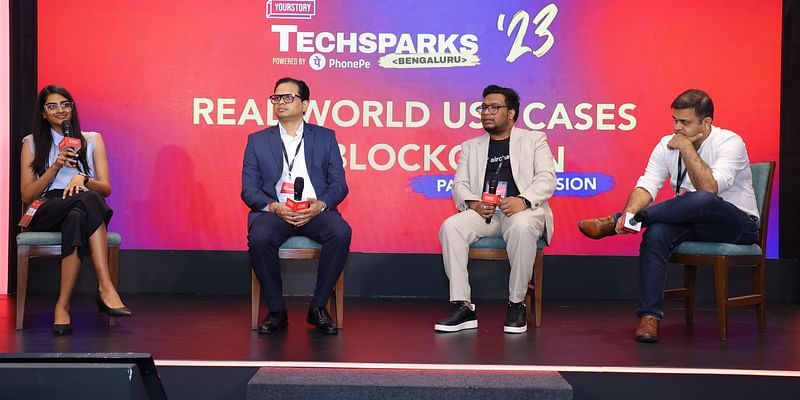
Blockchain is revolutionising sectors, enabling transparency in supply chains, secure voting, enabling trustworthy digital identities, and shaping a secure future.
At TechSparks 2023, Sharat Chandra, Co-founder, India Blockchain Forum; Ankur Rakhi Sinha, Co-founder, Airchains; and Gaurav Arora, Sr.Vice President, DeFi Initiatives, CoinDCX discussed blockchain adoption and its applications in various sectors like government, enterprise, and startups.
The session was moderated by Kaavya Prasad, Founder, Lumos Labs.
Government’s adoption of blockchain
With a surge in cyber threats and stricter data privacy regulations, blockchain stands as a transparent solution, especially for challenging use cases that are traditionally hard to safeguard with conventional infrastructures.
Addressing an initiative led by the Tamil Nadu government, Sharat Chandra noted, “The ‘Tamil Nadu Government Blockchain Backbone,’ features a citizen wallet system, where each citizen is issued a unique state ID. It consolidates essential documents like property records, birth and death certificates into a single wallet.”
This aims to enhance access to government services, marking growth in government-to-citizen service adoption, he added.
.thumbnailWrapper
width:6.62rem !important;
.alsoReadTitleImage
min-width: 81px !important;
min-height: 81px !important;
.alsoReadMainTitleText
font-size: 14px !important;
line-height: 20px !important;
.alsoReadHeadText
font-size: 24px !important;
line-height: 20px !important;

He highlighted a similar initiative in Karnataka—Aadhar for property, known as the Unified Land Management System. Emphasising the need for technology convergence, he noted that the Center for Smart Governance is integrating GIS, geospatial data, artificial intelligence, and imagery with blockchain to establish distinct property IDs.
In May, SEBI explored fractional ownership of real estate assets via a consultation paper named ‘Regulatory Framework for Micro, Small and Medium REITs (MSM REITs)’. The India Blockchain Forum and Crypto Legal, a blockchain policy advisory firm highlighted the need for an asset tokenization framework.
Moreover, GIFT City and IFSC (International Financial Services Centre) recently initiated a committee focusing on both physical and financial asset tokenisation, fueling the mass adoption of Web3.
Gaurav believes the government should leverage this technology to enhance its regulatory capabilities.
“Stepping back for a moment, let’s consider the fundamental role of government: rule creation and enforcement. Once assets are digitised, blockchain can efficiently assist the government in executing its role.”
Enterprise landscape
The blockchain space is ripe with potential, with closer attention to evolving policies. Many projects are making headway, by real-world asset tokenisation and the digitisation of land records.
“The momentum is undeniable, especially in integrating real-world assets like city complaints into blockchain. The number of use cases is expanding, from B2B scenarios involving specialized users to B2C applications enabling direct government-to-public interaction,” said Ankur Rakhi Sinha.
“Uttar Pradesh’s experiment with blockchain for police complaints and FIRs has been a win, further validating its success in real-world applications,” he added. He believes that even before B2B projects, institutions at the forefront are eager to deploy and pioneer use cases.
Surge of CBDCs
In the evolving landscape of global finance, Central Bank Digital Currencies (CBDCs) have emerged as a compelling force. Currently, a report suggests 87 countries, which represent more than 90% of global GDP, are exploring CBDCs.
Sharat added that governments and financial institutions are increasingly recognising the potential of CBDCs to revolutionise the way users transact with currencies. “The focus is to scale technology for potential 1 billion daily transactions and enable offline payments. The RBI targets one million monthly CBDC transactions, especially in micro-lending and micro-insurance,” he said.
He also believes that CBDC adoption can streamline DeFi (Decentralized finance) and facilitate compliance, making it an enabler for Web3.
Meanwhile, Gaurav noted that there will be a few CBDCs catering to retail and wholesale use cases.
“Wholesale use includes inter-country and inter-company transfers, especially for large transactions. The US dollar’s demand is high due to its usage in significant transactions such as oil payments. A CBDC with a global reach could potentially become the preferred means of wealth transfer,” he said.
“Despite initial hesitations, the US is now concerned about China’s growing CBDC influence and is considering active participation. It’s somewhat of a competitive race, and the fear of missing out (FOMO) can be a driving factor in this landscape,” he added.
The road ahead
Gaurav gave a simple yet often overlooked use case of blockchain in the automotive industry.
“For a standard car, there are approximately 30,000 parts sourced from around 4,000 vendors. Attempting to streamline this complex supply chain with conventional software can be daunting. Even if sophisticated software is developed, convincing these numerous vendors to adopt it is a major challenge. However, with blockchain technology, the scenario changes,” he illustrated.
“The technology offers the potential to create entirely new economic models, emphasising the need for fresh approaches rather than just modifying existing ones,” he noted.
Ankur suggested their current enterprise involvements might not lead to groundbreaking blockchain innovations. He believes that leveraging the technology to enhance existing experiences is the key.
“It’s not about reinventing processes but enhancing them through blockchain. Through various projects with enterprises, it’s evident that the focus is on refining customer service and existing operations rather than introducing entirely new concepts,” said Ankur.
Edited by Kanishk Singh



![Read more about the article [Funding alert] Insurance broker SecureNow raises $6M in Series B round](https://blog.digitalsevaa.com/wp-content/uploads/2021/12/MalvikaCopyofImageTagging2-1640772201551-300x150.png)






